highway and expressway guide signs are:

Highway and expressway guide signs are navigational aids providing essential information to drivers. They offer directions, points of interest, and road conditions, ensuring safe and efficient travel.
1.1 Purpose and Importance of Guide Signs
Highway and expressway guide signs are designed to provide clear and accurate information to drivers, ensuring safe and efficient navigation. Their primary purpose is to direct road users to their destinations by indicating routes, exits, and points of interest. These signs are essential for informing drivers about upcoming interchanges, cities, and essential services like hospitals, gas stations, and restaurants. By offering advance notice of road conditions, guide signs help drivers make informed decisions, reducing confusion and stress. They also play a critical role in traffic management, particularly at complex interchanges, by guiding drivers through lanes and exits. The standardized design of guide signs ensures consistency, making them easily recognizable and understandable for all road users. Ultimately, guide signs enhance safety and efficiency, serving as a vital component of modern transportation networks.
1.2 Types of Guide Signs
Highway and expressway guide signs are categorized into several types, each serving distinct purposes. Diagrammatic guide signs provide visual representations of exit arrangements, helping drivers understand complex interchanges. Directional signs indicate routes to cities, towns, and points of interest, often featuring arrows and distances. Informational signs highlight essential services like hospitals, restaurants, and gas stations, while destination signs guide drivers toward specific locations. These signs are designed to be universally understood, using standardized symbols and clear typography. Their placement and design ensure visibility and readability, even at high speeds. By categorizing guide signs into these types, they effectively address the diverse needs of drivers, enhancing navigation and reducing confusion on highways and expressways.
1.3 How Guide Signs Assist Drivers
Guide signs play a crucial role in enhancing driver safety and efficiency on highways and expressways. They provide clear and timely information, enabling drivers to make informed decisions without distractions. By offering advance notice of exits, intersections, and services, guide signs reduce the need for sudden lane changes or braking. This contributes to smoother traffic flow and minimizes the risk of accidents. Additionally, guide signs help drivers stay oriented, especially in unfamiliar areas, by indicating distances, directions, and key landmarks. They also highlight important facilities like rest areas, hospitals, and fuel stations, addressing practical needs during journeys. Overall, guide signs enhance navigation, reduce stress, and ensure drivers can focus on safe and efficient travel. Their effectiveness lies in their ability to communicate essential information quickly and clearly to all road users.
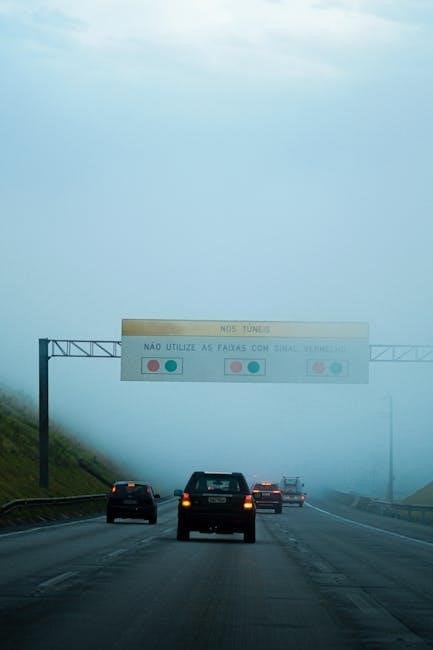
Classification of Guide Signs
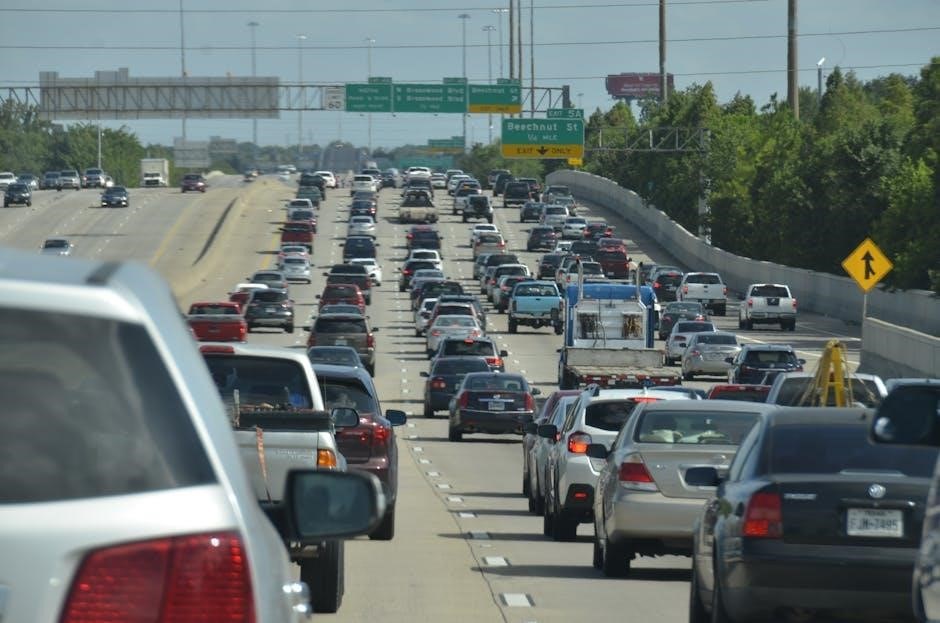
Guide signs are categorized into directional, service, and informational types, helping drivers navigate effectively by indicating exits, facilities, and key details along highways and expressways.
2.1 Major, Intermediate, and Minor Interchanges
Guide signs are categorized based on the type of interchanges they indicate: major, intermediate, and minor. Major interchanges connect primary highways or expressways, serving high volumes of traffic. These signs are often larger and provide detailed information to ensure smooth transitions. Intermediate interchanges link secondary roads or regional routes, offering guidance for drivers traveling shorter distances. Minor interchanges connect local roads, with signs designed to inform drivers about nearby amenities or smaller destinations. The classification helps drivers anticipate the scale and importance of upcoming junctions, ensuring efficient navigation. Clear differentiation in sign design and placement is crucial to avoid confusion, especially at high speeds. This hierarchy enhances safety and simplifies decision-making for motorists on highways and expressways.
2.2 Classification Based on Road Types (Highways and Expressways)
Guide signs are classified based on the type of road they serve, with distinct designs for highways and expressways. Highway guide signs provide directional and informational guidance for routes connecting cities, towns, and regional destinations. These signs often include distances, route numbers, and key landmarks to help drivers navigate long-distance journeys; Expressway guide signs, however, are tailored for high-speed traffic, focusing on upcoming exits, interchanges, and service areas. They are designed to be simple and quickly readable, minimizing distractions for drivers traveling at higher speeds. The classification ensures that signage aligns with the specific needs of each road type, enhancing safety and efficiency. This differentiation helps drivers make informed decisions based on their route and destination, whether on highways or expressways.
Design and Layout of Guide Signs
Guide signs are designed for clarity and readability, with standardized fonts, colors, and layouts to ensure quick comprehension by drivers. Bold typography and contrasting colors enhance visibility, while concise messaging minimizes distractions. Graphics and symbols are used to universally communicate directions and services, making the signs accessible to all road users.

3.1 Standardization of Guide Signs
Standardization of guide signs ensures consistency in design, messaging, and placement, making them easily recognizable and understandable for all drivers. Federal guidelines, such as the Manual on Uniform Traffic Control Devices (MUTCD), dictate specific standards for sign shapes, colors, fonts, and symbols. This uniformity helps drivers quickly identify directional information, service availability, and safety alerts. Standardized signs reduce confusion and enhance safety, especially for motorists traveling across different regions or states. The use of universally recognized symbols and concise text ensures clarity, even for drivers unfamiliar with the area. Additionally, standardized signs facilitate efficient communication, enabling drivers to make informed decisions without distractions. This consistency is critical for maintaining smooth traffic flow and ensuring public safety on highways and expressways.
3.2 Typography and Legibility
Typography and legibility are critical elements in the design of highway and expressway guide signs to ensure clear communication. Standardized fonts, such as Clearview or Highway Gothic, are used to maximize readability at high speeds and varying distances. Letter sizes and spacing are carefully calibrated to enhance visibility, with larger text for distance legibility and adequate spacing to prevent crowding. Uppercase letters are predominantly used for immediate comprehension, while serif fonts are avoided to minimize visual clutter. High contrast between text and background ensures visibility under diverse lighting conditions. Graphics and symbols are kept simple to avoid distraction, focusing on clarity. Regular testing ensures signs are legible for all drivers, including those with visual impairments. These design principles ensure that guide signs are effective in conveying essential information quickly and safely to motorists.
3.3 Use of Colors and Graphics
Highway and expressway guide signs rely heavily on the strategic use of colors and graphics to convey information quickly and effectively. Colors are standardized to ensure consistency and readability, with green, blue, and brown commonly used for guide signs on highways and expressways. Green is often reserved for directional and informational signs, while blue is used for motorist services like rest areas and food stops. Graphics, such as arrows, symbols, and logos, are employed to simplify complex information and enhance comprehension. These visuals are designed to be universally understood, minimizing language barriers. The combination of bold colors and clear graphics ensures that drivers can process information rapidly, even at high speeds. This design approach maximizes safety and efficiency, helping motorists navigate with confidence.

Installation and Placement of Guide Signs
Guide signs are strategically installed to ensure visibility, safety, and clarity for drivers. Proper placement considers traffic flow, speed limits, and road conditions to enhance readability and effectiveness.
4.1 Strategic Locations for Guide Signs
Guide signs are installed at critical decision points, such as exits, interchanges, and junctions, to provide drivers with clear and timely information. Strategic placement ensures visibility and readability, often positioned before curves, hills, or merges where driver decisions are necessary. Signs are typically placed far enough in advance to allow drivers sufficient time to react, especially on high-speed roads like highways and expressways. Standardized locations, such as overhead gantries or roadside posts, enhance consistency and safety. The placement also considers factors like traffic volume, road geometry, and driver behavior to maximize effectiveness. For instance, advance guide signs are positioned before exits, while directional signs are placed at intersections to guide drivers seamlessly. This strategic approach ensures that guide signs serve their purpose of reducing confusion and enhancing navigation for motorists.
4.2 Visibility and Spacing Requirements
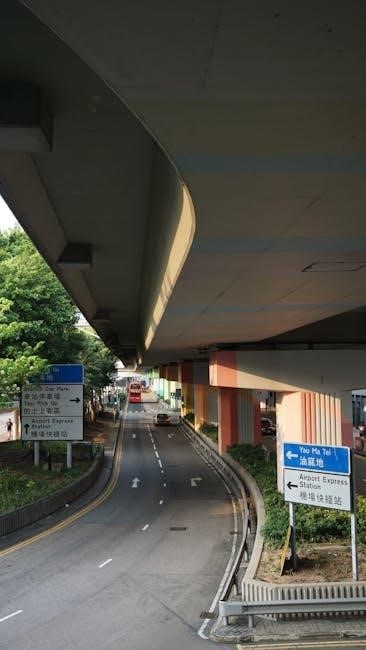
Visibility and spacing are critical for the effectiveness of guide signs. Signs must be visible from a distance, with lettering and graphics large enough to be easily readable at high speeds. The luminance contrast between the sign’s background and text ensures visibility under varying light conditions. Spacing requirements are determined by road speed limits, with signs placed farther apart on highways to accommodate higher speeds. The distance between consecutive signs is calculated to provide drivers with sufficient time to react. Mounting heights are standardized to ensure signs are above obstructions and within drivers’ line of sight. Retroreflective materials enhance nighttime visibility, reducing the need for external lighting. Proper spacing and visibility ensure that guide signs are functional, reducing driver confusion and enhancing traffic flow. Regular inspections and maintenance are essential to uphold these standards and ensure optimal performance.
Regulatory Compliance and Standards
Highway and expressway guide signs must adhere to federal and state regulations, ensuring consistency, safety, and clarity. Standards like the MUTCD dictate design, placement, and maintenance, promoting uniformity and driver understanding.

5.1 Federal and State Regulations
Highway and expressway guide signs in the U.S. are governed by federal and state regulations to ensure uniformity, safety, and clarity. The Manual on Uniform Traffic Control Devices (MUTCD), published by the Federal Highway Administration (FHWA), provides detailed standards for guide sign design, placement, and maintenance. States adopt these federal guidelines but may incorporate regional variations to address local needs. Compliance with these regulations is critical to maintain driver safety, reduce confusion, and ensure consistency across jurisdictions. Non-compliance can lead to penalties and potential safety hazards. Regular updates to these standards reflect advancements in technology, driver behavior, and infrastructure development. By adhering to federal and state regulations, guide signs effectively communicate essential information, enhancing overall traffic management and user experience on highways and expressways.
5.2 International Standards for Guide Signs
International standards for guide signs ensure consistency and clarity across borders, facilitating easier navigation for drivers in foreign countries. Organizations like the United Nations Economic Commission for Europe (UNECE) and the World Road Association (PIARC) play a key role in harmonizing these standards globally. Common elements include the use of universally recognized symbols, consistent color schemes, and standardized typography to enhance legibility. While regional variations exist due to language and cultural differences, the core principles of guide sign design remain aligned worldwide. Digital integration, such as electronic signs and real-time information, is increasingly adopted internationally to improve traffic management. These standards are regularly updated to reflect technological advancements and evolving driver needs, ensuring guide signs remain effective tools for safe and efficient travel on highways and expressways globally.

Regional Variations in Guide Signs
Regional variations in guide signs reflect local languages, cultural preferences, and regulatory requirements. Design differences include distinct color schemes, symbols, and typography, adapting to regional needs while maintaining core functionalities.
6.1 Differences in Guide Signs Across Countries
Guide signs vary significantly across countries due to differences in design standards, language, and cultural preferences. For example, European countries often use pictograms and simplified text, while American signs rely more on detailed text and arrows. In Japan, guide signs frequently include English translations alongside Japanese characters to accommodate international travelers. Color schemes also differ; Australia and the UK use green backgrounds for motorway signs, whereas the U.S. typically uses green for guide signs on highways. Additionally, some countries incorporate unique symbols or graphics to reflect local landmarks or regional identity. Despite these variations, most nations adhere to international standards, such as those outlined in the Vienna Convention on Road Signs and Signals, to ensure consistency and driver comprehension. These differences highlight the need for adaptability in signage design to meet regional needs while maintaining clarity and functionality.
Future Trends in Guide Signs
Future trends include integrating digital signage, real-time updates via smart devices, and energy-efficient materials, enhancing navigation and safety while reducing environmental impact.
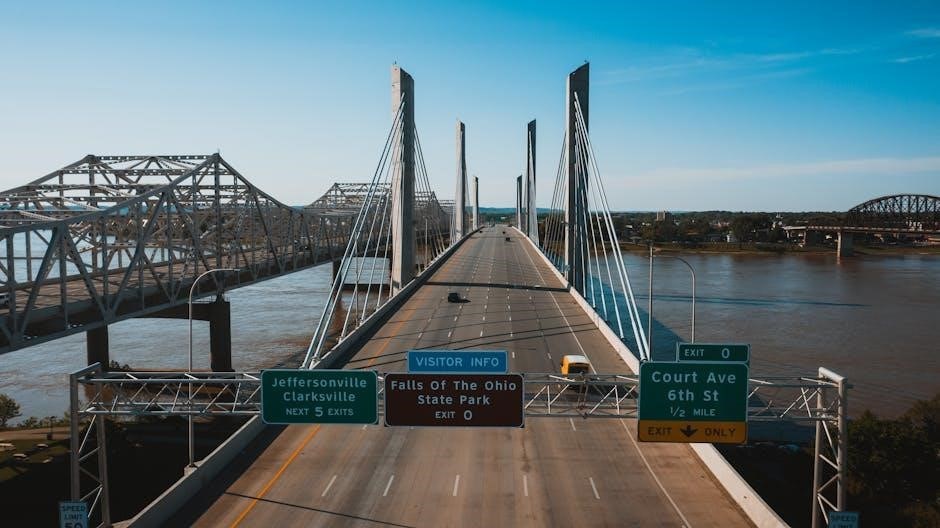
7.1 Integration of Digital Signage
The integration of digital signage into highway and expressway guide signs represents a significant leap forward in traffic management and driver communication. Digital signs, such as LED or LCD displays, offer real-time updates, enabling dynamic messaging based on current traffic conditions, accidents, or weather alerts. This technology allows for instantaneous information dissemination, improving driver decision-making and reducing congestion; Additionally, digital signage can be programmed to display multiple messages in rotation, maximizing the amount of information conveyed. These systems are often integrated with intelligent transportation systems (ITS), which use data from sensors and cameras to provide accurate, up-to-date information. The use of digital signage also enhances readability, as bright, high-resolution displays are easier to see from a distance. Furthermore, digital signs can be connected to smartphones or vehicle dashboards, offering personalized guidance; This innovation not only improves safety but also reduces the need for physical sign replacements, making it a cost-effective and environmentally friendly solution. As technology advances, digital signage will likely become a standard feature on highways and expressways worldwide, revolutionizing the way drivers navigate roads.
7.2 Smart Traffic Management Systems
Smart traffic management systems are revolutionizing the way highways and expressways operate by integrating advanced technologies to optimize traffic flow and enhance safety. These systems utilize real-time data from sensors, cameras, and GPS to monitor and respond to traffic conditions dynamically. By analyzing this data, smart systems can adjust traffic signal timings, divert traffic to alternative routes, and provide drivers with real-time updates through guide signs. This integration reduces congestion, lowers emissions, and improves travel times. Additionally, smart systems enable predictive maintenance by identifying potential issues before they escalate. The use of AI and IoT further enhances these systems, allowing for more precise and responsive traffic management. As smart traffic management systems become more widespread, they will play a crucial role in creating efficient, sustainable, and safer transportation networks for the future. Their ability to adapt to changing conditions makes them indispensable for modern transportation infrastructure.
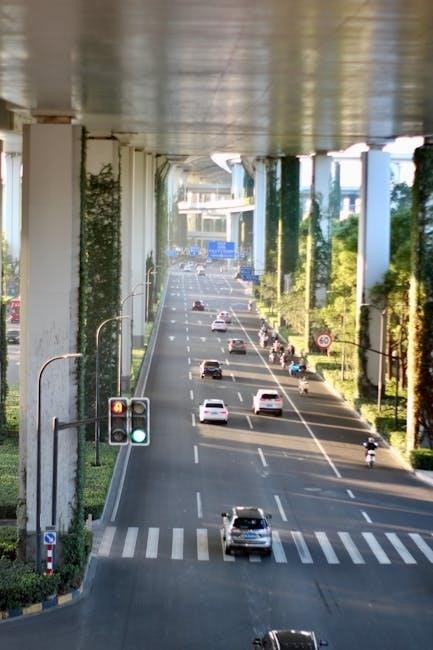
Maintenance and Upkeep of Guide Signs
Regular inspections, cleaning, and repairs ensure guide signs remain visible and accurate, maintaining safety and efficiency for drivers on highways and expressways.
8.1 Importance of Regular Maintenance
Regular maintenance of highway and expressway guide signs is crucial for ensuring driver safety and operational efficiency. Over time, signs can become faded, vandalized, or obscured by vegetation, reducing their visibility and effectiveness. Neglecting maintenance can lead to confusion among drivers, increasing the risk of accidents. Additionally, damaged or outdated signs may fail to provide accurate information, causing delays and frustration. Routine inspections help identify issues early, allowing for timely repairs or replacements. This not only extends the lifespan of the signs but also maintains compliance with federal and state regulations. Clean, well-maintained signs enhance readability, especially at night or in adverse weather conditions, contributing to smoother traffic flow. Ultimately, regular upkeep ensures that guide signs continue to serve their purpose effectively, supporting safe and efficient navigation for all road users.





